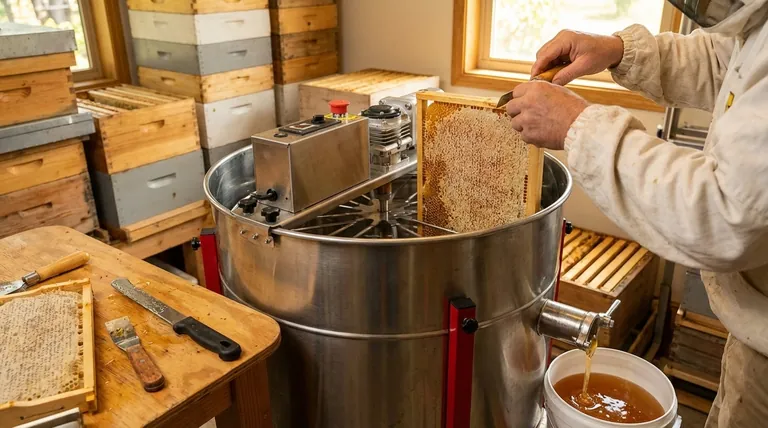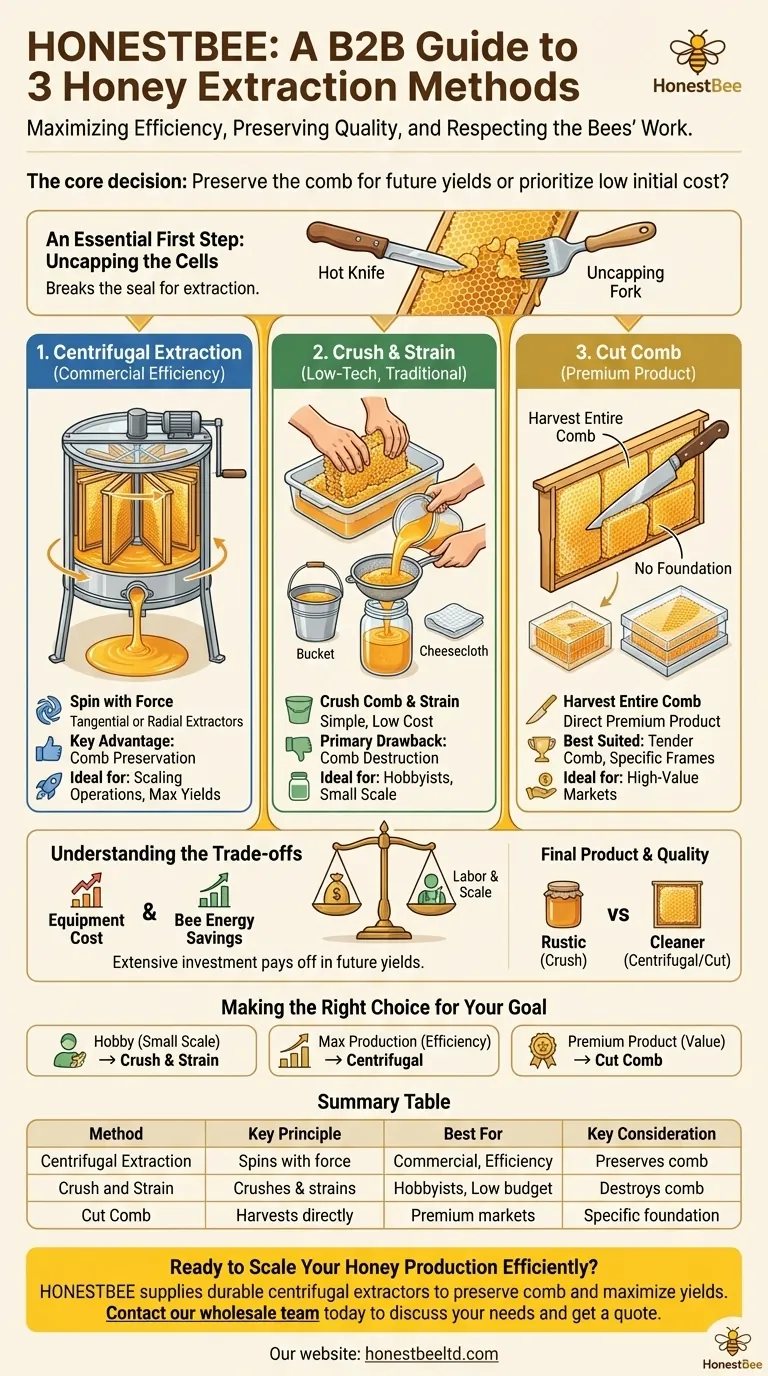The three primary methods for extracting honey are centrifugal extraction, the crush and strain method, and the cut comb method. Each approach serves a different purpose, ranging from large-scale efficiency that preserves the comb to small-scale techniques that produce a more rustic or premium product.
The core decision in choosing a honey extraction method comes down to a fundamental trade-off: do you want to preserve the delicate beeswax comb for the bees to reuse, or are you prioritizing simplicity and a lower initial equipment cost?

An Essential First Step: Uncapping the Cells
Before any liquid honey can be extracted, you must first remove the protective wax cappings that bees build over each filled honeycomb cell.
Why Uncapping is Necessary
The bees seal each cell filled with ripened honey with a fresh layer of beeswax. This capping protects the honey and keeps its moisture content stable. To get the honey out, this seal must be broken.
Common Uncapping Tools
Beekeepers typically use a specialized hot knife, which melts through the cappings, or an uncapping fork to manually scrape them away. This process exposes the liquid honey within the comb, preparing it for extraction.
Method 1: Centrifugal Extraction
This is the most common method used by beekeepers who manage more than a couple of hives. It relies on a machine called a honey extractor to spin the frames.
The Principle of Centrifugal Force
An extractor works like a centrifuge, using rotational force to sling the honey out of the cells and against the wall of the extractor drum. The honey then pools at the bottom, where it can be drained.
Types of Extractors
There are two main designs. Tangential extractors hold frames so one side faces out, requiring you to flip them halfway through. Radial extractors position frames like spokes on a wheel, extracting honey from both sides simultaneously and saving time. Both can be powered manually with a crank or by an electric motor.
The Key Advantage: Comb Preservation
The greatest benefit of this method is that it leaves the beeswax comb almost entirely intact. The empty frames can be returned to the hive, saving the bees the immense energy required to build new comb from scratch.
Method 2: The Crush and Strain Method
This is a low-tech, traditional approach that does not require an expensive extractor. It is exactly what it sounds like.
How It Works
The entire honeycomb is cut from the frame and crushed in a container, breaking open all the cells. The resulting mixture of honey and wax is then poured through a sieve or cheesecloth to separate the liquid honey from the pieces of wax.
When to Use This Method
This is a viable option for new beekeepers with only one or two hives who are not ready to invest in an extractor. It is a simple, straightforward process that requires minimal specialized equipment.
The Primary Drawback
The most significant downside is that this method completely destroys the comb. The bees must expend significant time and resources to rebuild all of it before they can store more honey.
Method 3: The Cut Comb Method
This method is less about extracting liquid honey and more about harvesting the honeycomb itself as the final product.
Harvesting Honeycomb Directly
Instead of separating honey from wax, the beekeeper uses a sharp knife to cut out pristine sections of filled honeycomb directly from the frame. These squares of honey-filled comb are then packaged and sold as a premium product.
Best Suited For Specific Frames
This technique works best when bees have built their comb on frames with either no foundation or a special, extra-thin foundation designed for this purpose. This ensures the beeswax is tender and pleasant to eat.
Understanding the Trade-offs
Choosing the right method requires balancing efficiency, cost, and your long-term goals as a beekeeper.
Equipment Cost vs. Bee Energy
A honey extractor is a significant investment, but it pays dividends by preserving the comb. Giving bees their drawn-out comb back allows them to focus solely on nectar collection, dramatically increasing potential honey yields in subsequent flows.
Final Product and Quality
The crush and strain method can sometimes incorporate more pollen and fine wax particles into the final honey, resulting in a more rustic product. Centrifugal extraction and cut comb typically produce a cleaner result.
Labor and Scale
For anyone managing more than a few hives, centrifugal extraction is vastly more efficient and less messy than crushing and straining large volumes of comb by hand.
Making the Right Choice for Your Goal
Your goals as a beekeeper will determine the best extraction method for you.
- If your primary focus is hobby beekeeping on a small scale: The crush and strain method is a simple and inexpensive way to get started without a large upfront investment.
- If your primary focus is maximizing honey production and efficiency: Investing in a centrifugal extractor is essential for preserving comb and scaling your operation.
- If your primary focus is creating a premium, high-value product: The cut comb method allows you to market beautiful sections of pure honeycomb directly to consumers.
Ultimately, the right technique aligns with your budget, your scale, and your respect for the bees' valuable work.
Summary Table:
| Method | Key Principle | Best For | Key Consideration |
|---|---|---|---|
| Centrifugal Extraction | Spins honey out of frames using force. | Commercial apiaries, efficiency. | Preserves comb for higher future yields. |
| Crush and Strain | Crushes comb and strains honey. | Hobbyists, small-scale, low budget. | Destroys comb; bees must rebuild. |
| Cut Comb | Harvests and sells honeycomb directly. | Premium product markets. | Requires specific foundation for best quality. |
Ready to Scale Your Honey Production Efficiently?
As a commercial beekeeper or equipment distributor, choosing the right extraction method is critical for your bottom line and the health of your bees. At HONESTBEE, we supply the durable, high-performance centrifugal extractors and uncapping tools that commercial operations rely on to preserve comb, maximize honey yields, and respect the bees' work.
Let us equip your apiary for success. Contact our wholesale team today to discuss your needs and get a quote.
Visual Guide

Related Products
- Electric 8 Frame Honey Spinner Extractor Equipment for Beekeeping
- HONESTBEE 3-Frame Manual Acrylic Honey Extractor
- HONESTBEE 72 Frame Industrial Electric Honey Extractor for Beekeeping
- 2 Frame Stainless Steel Manual Honey Spinner Extractor for Beekeeping
- 8-Frame Electric Self-Reversing Honey Extractor Spinner for Commercial Honey Extraction Equipment
People Also Ask
- What are the differences between manual and electric honey extractors? A Beekeeper's Guide to Power, Speed & Cost
- What is an extractor in beekeeping? Unlock Sustainable Honey Harvesting
- What machines are needed in beekeeping besides basic tools? Scale Your Honey Harvest Efficiently
- How long should you spin honey? Master the Art of Efficient, Damage-Free Extraction
- Why is cleaning a honey extractor important in beekeeping? Protect Your Honey Quality & Equipment



















